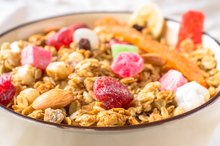Foods Containing Preservatives
When talking about preservatives in food, it might be easier to ask which foods don’t contain preservatives than which foods do. Unless you slaughter your own meat, raise your own chickens and grow your own fruits and vegetables, nearly everything you eat contains some type of preservative. The three main types of preservatives include antimicrobials, which slow bacterial growth; antioxidants, which slow oxidation in fats that causes food to become rancid; and substances that slow the natural ripening process that occurs after picking a fruit or vegetable.
Canned and Boxed Foods
Nearly every food that comes in a can, box or pouch contains some type of preservative. Since many processed foods sit on store shelves or in kitchen cabinets for months, adding preservatives keeps them from spoiling; spoiled, inedible food wastes money. One reason processed foods contain such high amount of sodium is because salt acts as a preservative. Antioxidants butylated hydroxytoluene, or BHT, and butylated hydroxyanisole, or BHA, keep oil from going rancid. Both are found in cereals, potato chips, oils and chewing gum and both have increased cancer risk in small animal studies. Propyl gallate, another antioxidant, is often used with BHA and BHT. Sulfites are added to some processed potatoes, while sodium benzoate, another preservative, is added to soft drinks, pickles and fruit juices.
- Nearly every food that comes in a can, box or pouch contains some type of preservative.
- Sulfites are added to some processed potatoes, while sodium benzoate, another preservative, is added to soft drinks, pickles and fruit juices.
Processed Meats
Foods That Contain EDTA
Learn More
Cured meats such as bacon, ham and sausage, as well as packaged lunch meats, contain the preservative sodium nitrate, which keeps the meats looking red or pink rather than gray. The meat industry justifies their use because nitrites also prevent the growth of botulism in the meats, the Center for Science in the Public Interest reports. Nitrites may also increase the risk of developing cancer, CSPI warns.
Fresh Meats
Although fresh meats would seem to be at low risk of added preservatives, meats in the grocery store may have carbon monoxide added to preserve their pink color and make them look more appealing, Rick Weiss of “The Washington Post” reported on Feb. 20, 2006. The color preservation may mask the fact that meat has spoiled. The European Union has banned the practice, Weiss notes.
Baked Goods
What Are the Dangers of Preservatives?
Learn More
Fresh baked goods often have preservatives added to retard mold growth. Antimicrobials such as propionic acid and antioxidants such as lecithin prevent oils from going rancid. Emulsifiers such as monoglycerides and diglycerides keep oils in baked goods from separating from other ingredients. Fruit pies and pastries may contain sodium benzoate.
- Fresh baked goods often have preservatives added to retard mold growth.
- Antimicrobials such as propionic acid and antioxidants such as lecithin prevent oils from going rancid.
Salad Ingredients
Salad ingredients sold in supermarkets and restaurants often have sulfites added to keep them looking fresh. Sulfites cause severe allergic reactions in some people, particularly in asthmatics.
Dairy Products
Dairy products such as milk, cheese, sour cream, ice cream and yogurt have a number of added preservatives, including potassium sorbate, natamycin, used to prevent mold growth on cheese and tartaric acid.
Related Articles
References
Writer Bio
A registered nurse with more than 25 years of experience in oncology, labor/delivery, neonatal intensive care, infertility and ophthalmology, Sharon Perkins has also coauthored and edited numerous health books for the Wiley "Dummies" series. Perkins also has extensive experience working in home health with medically fragile pediatric patients.








